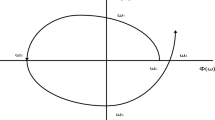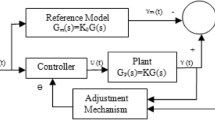Abstract
A method for calculating the parameters of controllers for nonlinear nonstationary dynamic systems is proposed. The structure of the controller is a generalization of the structure of proportional-integral and proportional-integral-differential controllers. The method is applicable to unstable nonlinear systems with incomplete information on the plant model. The method is based on the deliberate formation of different-rate processes in a control system in which the stability of fast processes is provided by choosing the controller parameters, and the slow processes formed correspond to the reference model of the desired behavior of a nonlinear system. An example of the results of numerical simulation is given.
Similar content being viewed by others
References
V. Ya. Rotach, Automatic Control Theory: A Textbook for High Schools (MEI, Moscow, 2008) [in Russian].
A. M. Shubladze and S. I. Kuznetsov, “Automatically Adjusted Industrial PI and PID Controllers,” Avtomatizatsiya v Promyshlennosti, No. 2, 15–17 (2007).
A. G. Aleksandrov and M. V. Palenov, “Self-Tuning PID/I Controller,” AIT, No. 10, 4–18 (2011).
K. J. Astrom and T. Hagglund, PID Controllers: Theory, Design, and Tuning. Research Triangle Park: Instrum. Soc. Amer., 1995.
A. O’Dwyer, Handbook of PI and PID Tuning Rules (Imperial College Press, London, 2003).
Y. Li, K. H. Ang, and G. C. Y. Chong, “PID Control System Analysis and Design,” IEEE Control Syst. Magazine 26(1), 32–41 (2006).
V. D. Yurkevich, Synthesis of Nonlinear Nonstationary Control Systems with Different-Rate Processes (Nauka, St. Petersburg, 2000) [in Russian].
V. D. Yurkevich, Design of Nonlinear Control Systems with the Highest Derivative in Feedback (World Scientific, 2004).
A. N. Tikhonov, “Systems of Differential Equations Containing Small Parameters at Derivatives,” Matematicheskii Sbornik 31(3), 575–586 (1952).
E. I. Gerashchenko and S. M. Gerashchenko, Method of Motion Separation and Optimization of Nonlinear Systems (Nauka, Moscow, 1975) [in Russian].
N. N. Krasovskii, “On the Stability of Solutions of a System of Two Differential Equations,” Prikl. Matematika Mekhanika 17(6), 651–672 (1953).
D. S. Naidu, “Singular Perturbations and Time Scales in Control Theory and Applications: An Overview,” Dynamics of Continuous, Discrete and Impulsive Systems (DCDIS). Ser. B: Applications&Algorithms. 9(2), 233–278 (2002).
P. D. Krut’ko, “Designing Algorithms for Controlling Nonlinear Plants Based on the Concept of Inverse Problems of Dynamics. Controlling Motion Relative to the Center of Mass,” Izv. Akad. Nauk SSSR. Ser. Tekhnicheskaya Kibernetika, No. 6, 129–138 (1986).
P. D. Krut’ko, Inverse Problems of Dynamics in Automatic Control Theory. Series of Lectures: A Handbook for Schools (Mashinostroenie, Moscow, 2004) [in Russian].
A. S. Vostrikov, Synthesis of Control Systems by the Localization Method (Novosibirsk State Technical University, Novosibirsk, 2007) [in Russian].
A. S. Vostrikov, “Controllers Synthesis for Automation Control Systems: State and Prospects,” Avtometriya 46(2), 3–19 (2010) [Optoelectr., Instrum. Data Process. 46 (2), 107–120 (2010)].
V. D. Yurkevich, “Adaptive Gain Tuning in Nonlinear Control Systems Designed Via Singular Perturbation Technique,” in: Proc. of the 18th Intern. Conf. on Control Applications Part of the 3rd IEEE Multi-Conference on Systems and Control, Saint Petersburg, Russia, July 8–10, 2009, 37–42.
V. D. Yurkevich, “PI/PID Control for Nonlinear Systems Via Singular Perturbation Technique,” Advances in PID Control. InTech, 2011, 113–142.
Yu. N. Zolotukhin and A. A. Nesterov, “Inverted Pendulum Control with Allowance for Energy Dissipation,” Avtometriya 46(5), 3–10 (2010) [Optoelectr., Instrum. Data Process. 46 (5), 401–407 (2010)].
Author information
Authors and Affiliations
Corresponding author
Additional information
Original Russian Text © V.D. Yurkevich, 2012, published in Avtometriya, 2012, Vol. 48, No. 5, pp. 24–31.
About this article
Cite this article
Yurkevich, V.D. Calculation and tuning of controllers for nonlinear systems with different-rate processes. Optoelectron.Instrument.Proc. 48, 447–453 (2012). https://doi.org/10.3103/S8756699012050032
Received:
Published:
Issue Date:
DOI: https://doi.org/10.3103/S8756699012050032




